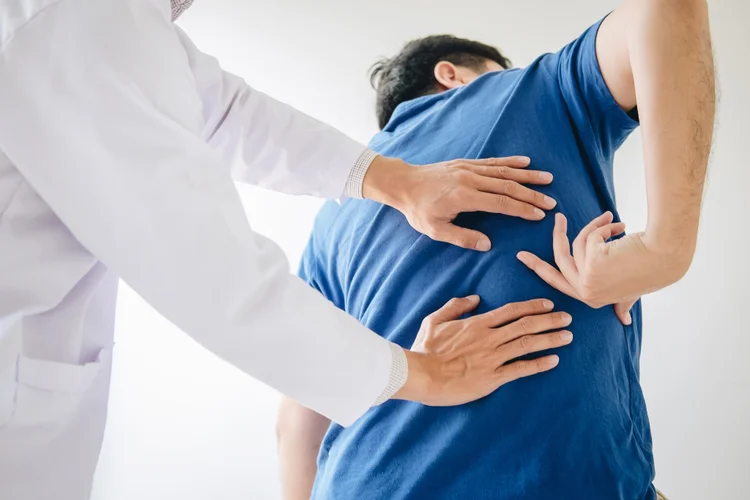Back Pain Specialist Doctor
Back pain can result from muscle strain, disc issues, or poor posture. At Apex Sports Clinic, Dr Foo offers thorough assessments and targeted care to relieve pain, restore mobility, and support long-term spinal health.
MBBS (University of London) | MMed (Ortho) | FRCSEd (Ortho) | FAMS (Ortho)



Back pain is one of the most common musculoskeletal conditions, affecting
individuals of all ages and lifestyles. It can range from mild discomfort to
severe, debilitating pain that interferes with daily activities, work, and sports
performance.
While occasional back pain may subside on its own, ongoing or worsening
symptoms shouldn’t be ignored, as they may signal an underlying issue that requires
professional diagnosis and targeted treatment.
Type & Causes of Back Pain
Back pain can vary in severity, duration, and sensation, depending on its underlying
cause.
Some types arise from mechanical strain, while others stem from nerve irritation, inflammation, or
referred pain. Understanding these differences can help determine the most appropriate treatment
approach.
| Type of Back Pain | Description | Common Causes |
|---|---|---|
| Acute Back Pain | Sudden onset, typically lasting less than six weeks. | Muscle strain, ligament sprains, minor injuries, poor posture, sudden movements, heavy lifting. |
| Chronic Back Pain | Persists for more than three months and may require long-term management. | Degenerative conditions (e.g., osteoarthritis, herniated discs), persistent inflammation, degenerative disc disease. |
| Mechanical Back Pain | Pain originating from the muscles, joints, or bones of the spine, often aggravated by movement and physical activity. | Poor posture, repetitive strain, prolonged sitting or standing, weak core muscles, improper lifting techniques, and spinal misalignment. |
| Neuropathic Back Pain | Sharp, burning, or radiating pain caused by nerve compression or irritation. | Sciatica, spinal stenosis, nerve root compression, diabetic neuropathy, post-surgical nerve damage, severe spondylolisthesis with nerve involvement. |
| Inflammatory Back Pain | Stiffness and pain that improves with movement and worsens after rest. | Autoimmune conditions (e.g., ankylosing spondylitis, rheumatoid arthritis), infections like spinal tuberculosis, inflammatory bowel disease (IBD). |
| Referred Back Pain | Pain originating from other organs but felt in the back. | Kidney disease, gastrointestinal disorders, infections, abdominal aortic aneurysm, endometriosis. |
When to Seek Medical Attention for Back Pain?
While mild back pain often resolves on its own, certain symptoms indicate a more serious condition
that requires medical evaluation.
Seek medical attention if you experience:
- Persistent pain lasting more than a few weeks.
- Worsening pain despite home remedies or over-the-counter medication.
- Pain radiating down the legs, or numbness, tingling, or weakness in the lower body.
- Difficulty standing, walking, or maintaining balance.
- Pain following an injury, accident, or fall.
- Back pain with additional concerning symptoms, such as unexplained weight loss, fever, or changes in bowel or bladder function.
Diagnosing Back Pain
At Apex Sports Clinic, diagnosing back pain involves a comprehensive evaluation to identify whether
the cause is due to musculoskeletal strain, nerve involvement, structural abnormalities, or
a systemic condition.
This may involve physical assessments, imaging, and nerve studies where needed to
help guide diagnosis and inform treatment decisions.

- Medical History Review – Assessing symptoms, lifestyle factors, and any past injuries or medical conditions.
- Physical Examination – Evaluating posture, range of motion, muscle strength, and neurological function.
- Imaging Tests – Using X-rays to detect bone abnormalities or fractures, MRI to assess soft tissues like discs and nerves, and CT scans to provide detailed cross-sectional views of spinal structures.
- Electrodiagnostic Tests – Conducting nerve conduction studies or electromyography (EMG) to assess nerve function and detect conditions like radiculopathy or neuropathy.
Back Pain Treatment
Back pain treatment follows a patient-centred and progressive approach, tailored to
the underlying cause, severity, and duration of symptoms.
Most cases are managed with non-surgical treatments, while surgery is considered
only if conservative approaches fail or significant nerve compression is present. If back pain is
due to a referred condition, collaboration with other specialists may be necessary to address the
root cause.
Some of the specialised treatments we provide include:
| Treatment | Description & Purpose |
|---|---|
| Corticosteroid Injections | An injection that delivers anti-inflammatory medication around irritated spinal nerves or joints to help reduce swelling and alleviate pain caused by nerve compression or joint inflammation. |
| Nerve Blocks | Injection of anesthetic near specific nerves, often under ultrasound or fluoroscopic guidance, to temporarily interrupt pain signal transmission. Helps provide relief for severe or persistent pain that does not respond to conservative treatments. |
| Radiofrequency Ablation | Uses heat generated by radio waves to selectively disable overactive nerve fibers responsible for pain. Helps reduce chronic pain associated with arthritis, nerve compression, or spinal conditions. |
| Discectomy | A procedure to remove part of a herniated disc that is pressing on a nerve, commonly done for conditions like sciatica or nerve compression. |
| Laminectomy | Surgically removes a portion of the vertebral bone (lamina) to relieve pressure on the spinal cord or nerves. Helps improve mobility and reduce pain from conditions such as spinal stenosis or nerve compression. |
| Spinal Fusion | Surgical fusion of two or more vertebrae using bone grafts or implants to reduce pain. It can help stabilise the spine in cases of severe degeneration or instability. |
Preventing Back Pain

While not all causes of back pain can be prevented, proactive measures can reduce the risk of recurrence or severity:
- Maintain Proper Posture – Keep the spine aligned when sitting, standing, and lifting to minimise strain.
- Engage in Regular Exercise – Strengthen core and back muscles to support spinal stability.
- Use Ergonomic Furniture – Adjust chairs, desks, and workstations to promote proper spinal alignment.
- Practice Safe Lifting Techniques – Bend at the knees, keep the back straight, and lift with the legs to prevent strain.
- Manage Body Weight – Maintain a healthy weight to reduce excessive stress on the spine.
Choosing the Best Back Pain Specialist in Singapore
Selecting a back pain specialist who is right for you depends on your specific
condition, as well as your treatment preferences and recovery
goals.
When deciding on a clinic or provider, consider factors such as clinical
focus,access to imaging and diagnostic services, and the availability
of both conservative and surgical options.
A multidisciplinary setting that includes physiotherapy and rehabilitation can also support
long-term recovery. Ultimately, it is important to choose a specialist who understands your
priorities and offers a treatment plan tailored to your needs.
If you're exploring your next steps, our friendly and experienced doctors at Apex are ready to
support you with personalised care and guidance. Book a consultation today.
Every patient deserves a treatment plan tailored to their needs. We start with non-surgical approaches before considering more invasive interventions.
Find a Back Pain Specialist Near Me
Apex Novena
admin@apexsportsclinic.sg
101 Irrawaddy Rd, #18-12 Royal Square Medical Centre, Singapore 329565
Nearest MRT: NS20 Novena
Apex East Coast
admin@apexsportsclinic.sg
112 E Coast Rd, #03-03/04 i12 Katong, Singapore 428802
Nearest MRT: TE26 Marine Parade
Why Do Patients Choose Apex Sports Clinic?
Sports Doctor in Singapore: Personalised & Affordable Care
Progressive Treatment Philosophy
We prioritise personalised, non-invasive solutions, progressing to specialised treatments, including surgery, only when needed for more effective and targeted care.
Holistic Patient-Centred Care
From diagnosis to rehabilitation, we provide comprehensive and seamless care for a wide range of orthopaedic conditions.
Specialist in Sports Orthopaedics & Injury Management
We combine expert injury management with a proactive approach to maintaining your body’s strength and function, so you can recover fully and perform at your peak.
Patient Journey
1 . Schedule Your Appointment

2 . Expert Diagnosis & Consultation

3 . Customised Treatment Plan

Schedule an Appointment

Our Insurance Partners






Frequently Asked Questions (FAQs)
Professional management of chronic low back pain typically involves a combination of conservative treatments, such as physiotherapy, pain management, activity modification, and lifestyle changes. In some cases, interventional procedures or surgery may be considered if symptoms persist. It is advisable to consult a doctor or specialist to help determine the most appropriate management approach for chronic low back pain.
Back pain in females can result from musculoskeletal strain, hormonal changes, osteoporosis, pregnancy-related changes, or conditions like endometriosis or arthritis. In some cases, referred pain from pelvic or gastrointestinal organs may contribute to back pain. As the causes can vary widely, consulting a doctor or specialist is advisable for proper diagnosis and to determine an appropriate treatment plan.
An orthopaedic specialist, particularly one experienced in spine conditions, is commonly consulted first for back pain. Physiotherapists are often involved in the treatment process after diagnosis. Depending on the underlying cause, other specialists such as neurologists, rheumatologists, or pain management doctors may also be involved.
Back pain may be serious if it is persistent, progressively worsening, or associated with symptoms like numbness, weakness, unexplained weight loss, fever, or bowel or bladder changes. Such signs may indicate underlying conditions requiring urgent evaluation. Consulting a doctor or specialist promptly is advisable if these symptoms occur to prevent complications and to determine appropriate treatment.
Muscle-related back pain usually feels sore, stiff, or achy and often improves with rest, while disc-related pain can cause sharp, radiating pain into the limbs, sometimes with numbness or weakness. However, symptoms can overlap, and distinguishing the exact source without medical assessment can be difficult. It is advisable to consult a doctor or specialist if you experience back pain that persists, worsens, or affects daily activities.
Managing back pain often involves rest, gradual return to activity, physiotherapy, proper posture, and, if needed, medications such as non-steroidal anti-inflammatory drugs (NSAIDs). Long-term relief typically includes strengthening the core muscles and maintaining good ergonomics. If back pain persists or worsens, it is advisable to consult a doctor or specialist for proper diagnosis and appropriate treatment to support recovery and prevent recurrence.
Sleeping with back pain can be improved by lying on your back with a pillow under the knees or on your side with a pillow between the knees to maintain spinal alignment. A supportive mattress and gentle stretching before bedtime may also help ease discomfort. It is advisable to consult a doctor if sleep disturbances persist, as addressing the underlying cause of back pain is important for overall recovery and restful sleep.
Lower back pain from sitting often improves with regular posture adjustments, ergonomic chairs, lumbar support, and taking frequent breaks to stretch and walk. Strengthening the core and hip muscles through targeted exercises can also reduce strain on the lower back. Consulting a doctor or specialist can help determine if postural correction, physiotherapy, or additional treatment is needed, especially if sitting-related back pain persists or worsens.
Sudden back pain can result from muscle strain, ligament sprain, disc problems, or changes in posture or activity levels. Less commonly, it may be linked to underlying spinal or systemic conditions. Immediate triggers are often minor and resolve with rest, but persistent or severe symptoms should not be ignored. Consulting a doctor or specialist is advisable to rule out serious causes and to guide appropriate treatment for sudden back pain.

